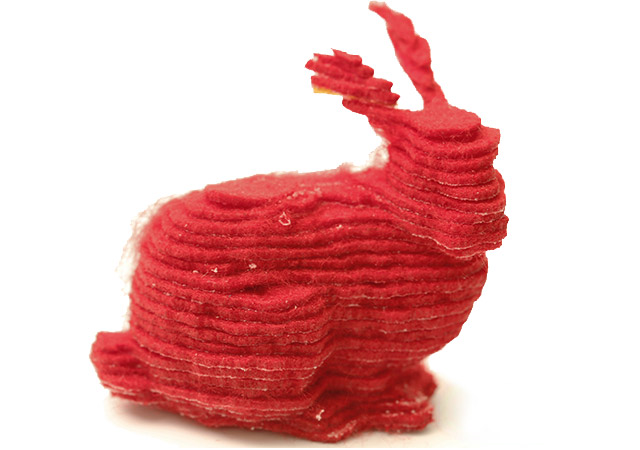
Most 3D printers rely on Fused Deposition Modeling (FDM) to produce objects, extruding melted plastic layer upon layer at specific points. That’s not exactly viable for textiles, which must be sewn together, but researchers built around that functional limitation with a clever two-part system. First, a powerful laser cuts a rectangle out of cloth held by a vacuum and shapes it into a single cross-section of the desired 3D object. Then the vacuum is shut off and the fashioned material falls into place on top of previously-cut layers. After it’s bonded with a heat-sensitive adhesive and finishes cooling, the printing continues until the machine reaches the final layer. The excess material is then cut away to reveal the finished product: a cuddly, 3D-printed plush.
Simple fabric is just the beginning, write the researchers. Not only can the flexibility of the object can be tailored precisely by varying the cuts, but using material with electrically conductive fibers can extend that conductivity to the objects themselves. The researchers experimented with a starfish that responds to touch and LED-powering smartphone case.
The research remains firmly in the academic phase for now — the co-authors are presenting the paper at the annual Conference on Human Factors in Computing Systems in Seoul, South Korea. And given the slow speeds of most 3D printers, the process isn’t exactly tenable for mass production. But as the technology behind the it inevitably advances, novel applications could spring up. Who knows, maybe during your next visit to a Disney Store you’ll be able to watch a plush print before your eyes.
Editors' Recommendations
- 3D printed cheesecake? Inside the culinary quest to make a Star Trek food replicator
- Need a last-minute Halloween costume? Check out these 3D-printable getups
- The best 3D printers under $500
- The future of making stuff: Inside the evolution of 3D printing with Formlabs
- Super Mario 3D World + Bowser’s Fury trailer reveals wild new game mode


